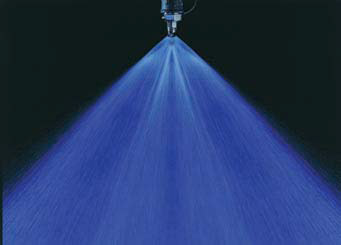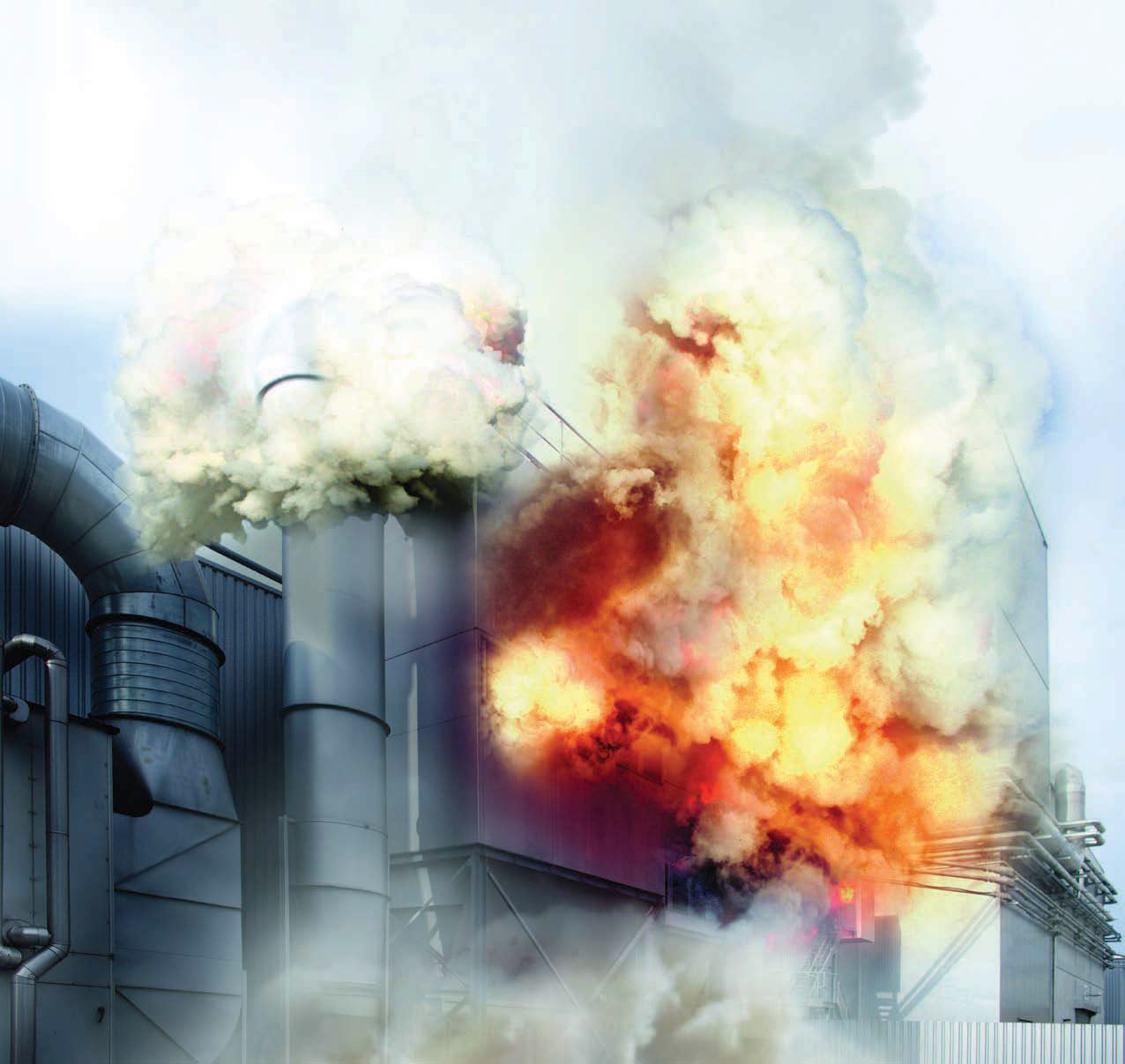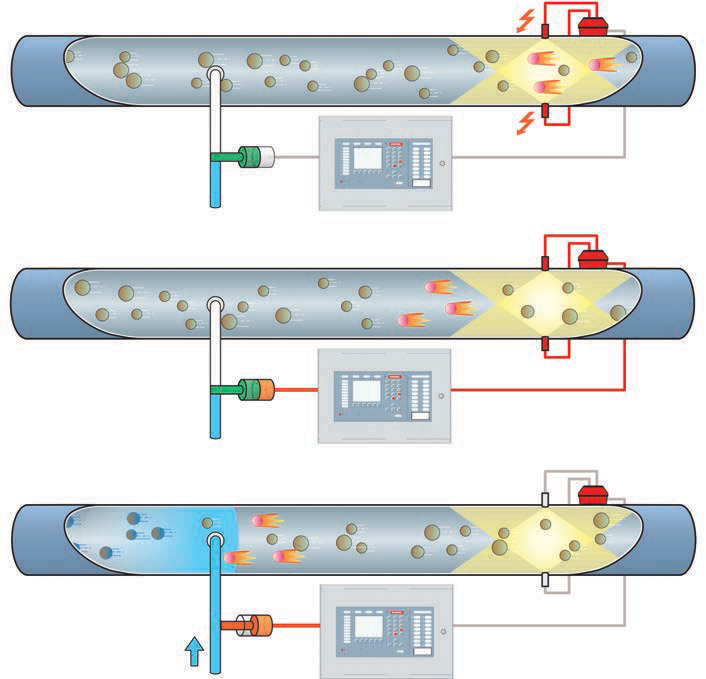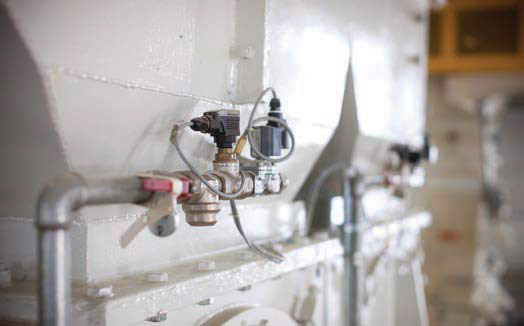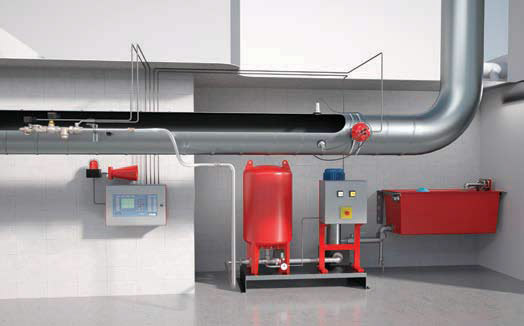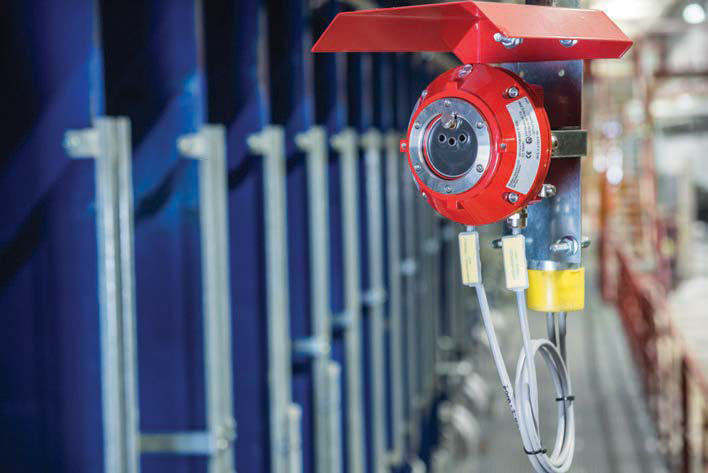Total Protection
21 December 2018Minimax, based in Bad Oldesloe in northern Germany, has an international reputation for on-the-line fire protection system for panel factories. However, there is much more to this company, as Mike Botting discovered
As a panel manufacturer, you are almost certain to have heard of Minimax and to be familiar with its products, which can protect your machinery from fire.
Of course this is done by a combination of detection, and extinguishing, of sparks or flames. That, at least, will be the part of Minimax that you know.
However, this is a company which employs more than 8,000 people worldwide, has a total turnover of around €1.6 billion, and more than 70 fire protection businesses worldwide.
The group is involved in the energy, marine and industrial sectors. The last-mentioned includes the wood sector, while also covering any other industries where specialised fire protection expertise is required.
So, you may guess that there is a lot more to Minimax than protecting your panel production machinery.
Matthias Berthold, head of competence for wood, paper and textiles (there’s a clue in itself), summed up the company’s mission with one sentence: “Safety along the entire production process”.
The Minimax brand was founded in 1902, when Wilhelm Graaff launched his hand-held, conical, fire extinguisher.
In 1968, the company opened its fire protection research centre, which today is a state-of-the-art building, involved in fire testing on a grand scale.
In 1970, the company entered the ‘International system integration market” and then began establishing several local business for that market – a process which has continued to the present day.
Another landmark for the company came in 2005, when it acquired Flamex Inc of Greensboro, North Carolina.
This was followed, in 2007, by the incorporation of Consolidated Fire Protection of Irvine, California.
In 2009, Minimax merged with Viking, another specialist in fire protection, based in Hastings, Michigan, US, to form the Minimax Viking Group.
Today, Minimax Viking produces all the key components for its fire solutions at its various locations.
The company manufactures smoke detectors, flame detectors, spark detectors, heat detectors, smoke aspirating systems, and water, foam and gas-based fire suppression systems. The latter employ gases which are harmless enough that you could be in the same room when the gas is released (if you really find it necessary!).
All these systems can be controlled from one panel.
So you can see that it is not just your actual production line that Minimax can protect, but your whole factory, including ducting, silos, production hall and warehousing. It even offers fire detectors for your log yard. Of course, office fire suppression systems are also available.
For instance, Arauco and Egger have both purchased complete-factory systems from Minimax; and Kronospan in Chirk, UK, has systems in most areas of its factory.
The development of all these systems is, of course, ongoing, and Minimax has extensive testing facilities at its Research & Development (R&D) centre at its very substantial international headquarters in Bad Oldesloe.
The fire testing centre consists of a 350m3 insulated building with a mobile ceiling to set the appropriate height for a given situation. The maximum ceiling height is 15m and large fires can be simulated in this building. There are also various laboratories for automated water distribution recordings and the testing of fire detectors. There are around 100 employees in the R&D division alone.
The main focus of the R&D centre is on the development and testing of sprinkler/deluge systems to European and international standards; water mist and spark extinguishing systems; gas-based suppression systems; and fire detection and suppression control systems.
The Michigan company also has such a testing building, which can go up to 12m high, specialising in sprinkler systems.
In Italy (Bressana Bottarone) the company specialises in foam-based R&D.
Bad Oldesloe and Greensboro are focused specifically on the wood industry.
Minimax says it offers a full service to its customers, from design through engineering, manufacturing, project management, installation, start-up and after-sales service.
Each project has one person at Minimax responsible for the whole project and providing a point of contact for the customer at all times – even five years after installation. So, it’s just as well that Minimax has a very loyal workforce, many of whom have over 20 years’ service with the company.
The wood industry competence centre employs 20 people dealing with Minifog systems only and these people know the wood industry inside out, said Mr Berthold.
“We started in the spark extinguishing business over 40 years ago and were the first company to develop such a system,” he said. “We were in at the beginning of the continuous press and are well-known for our Minifog PressProtect system.”
Minifog is designed to use the minimum amount of water for the maximum extinguishing effect, as we shall see later.
Minifog PressProtect
The Minifog PressProtect System is designed to operate on both multi-opening and continuous presses, where wood chips/ fibres, combined with paraffin, adhesives and flammable hydraulic and thermal oils, can present a fire hazard.
In addition to tests on the extinguishing system itself, Factory Mutual, the standards organisation for North America, wanted the effect of the extinguishing water on the stainless steel belt to also be tested. This was done successfully and no damage was caused to the belt.
Minimax usually installs five zones in a continuous press, to avoid spraying the entire press for a small fire, but all five zones can be activated in the event of a major press fire. Major risk areas are at the infeed and outfeed of the continuous press.
Flame detectors are located around the press, as well as in the closed areas, such as heat tunnels. The press pit is treated as a separate extinguishing zone, with the application of a special foaming agent in the event of a fire.
Minimax uses fibre optic cables in particularly hot areas, keeping conventional wiring away from close proximity to the hot press. The fibre optic detectors are selfmonitoring for when they need cleaning (more detail on that later in this article).
“The insurers wanted an optical representation of the press in the control room, on a panel with clear buttons, to avoid confusion,” said Mr Berthold. “The system includes a manual over-ride on the control panel and all the components of the system are self-monitoring.”
Another problem of the past that has been overcome is the accidental triggering of the extinguishing system by external flashing lights (camera flashlights used to be banned in many factories, as I know to my cost! - editor).
“The Minifog water mist increases in volume by a factor of 1,600 when it is injected into a fire,” explained Mr Berthold. “The nozzles are designed to operate on machines and directly onto hot spots; they are not designed for open-space fires.”
The water supply to the nozzles is only 4 bar, so a normal water supply can be used; and the same water system can be used for a sprinkler system. However, Minifog PressProtect systems can operate up to a maximum of 16 bar.
At the heart of the system is the deluge valve. This controls the distribution of the water to the nozzles and is activated by a solenoid. Once activated, the valves remain open, even if electrical power is lost.
Mr Berthold said that 300 PressProtect systems have been sold so far, worldwide. Sales are made through the main press suppliers – Dieffenbacher and Siempelkamp – as well as directly to the mills.
A new spark detector
“We have just brought a new spark detector to the market which sets us apart from our competitors,” said Mr Berthold. “This is because it is the first to detect contamination on the optical window of the detector itself. This can constitute a build-up of dust, or a glue film. The detector then sends a signal to the control panel to warn the operator that the lens needs cleaning. This removes the need to stop the line at regular intervals, just to check the detectors.
“The system is already in operation on our flame detectors on continuous presses,” he added.
Wood chips and dust present a constant risk of fire and conveying systems are one of the areas at highest risk.
In a typical pneumatic conveying tube, there would be three detectors using infrared detection, followed by spray nozzles.
“These nozzles produce a 180 degree curtain of water, covering the whole area of the conveying tube and this design is patented and unique on the market,” said Mr Berthold. “The spray nozzles are flush-mounted so there is no protrusion into the tube. When activated, the nozzle comes out, sprays, and then retracts again once the fire risk is over.
“All our systems are approved: by VDS in Germany; FM in North America; and UL, also in North America. We stipulate that all our systems must have at least one of these approvals. Some of our competitors don’t do this, in order to reduce the price of their systems,” added Mr Berthold.
New camera system
This new development employs a speciallydesigned infra-red camera, which offers the ability to detect hot spots and is already in use in the recycling industry.
The camera scans larger areas, such as warehousing, wood/log piles, yards, factory areas, etc. It scans for temperature changes and can automatically trigger the extinguishing system. The operator can define a precise area to scan, avoiding obstructions such as fork-lifts or trucks parked in the field of vision.
Another useful feature of this camera system is that it can detect hot spots in machinery, such as worn bearings or other machine parts, giving advance warning of possible failure in otherwise invisible parts of the machinery.
Look out for details of this innovation on Minimax’s stand at Ligna in May 2019.
In summary
Minimax is a very large international company specialising only in fire protection. It offers integrated systems for your complete factory complex. It also offers detection/extinguishing systems for offices, schools, hospitals, etc.
The company’s products are sold in many industries, from the seas to the land of every continent.
At nearly 120 years old, Minimax is obviously a well-established company with a long history and, it seems, a promising future.
